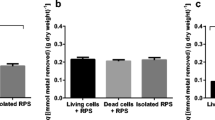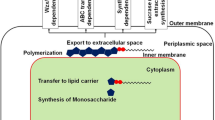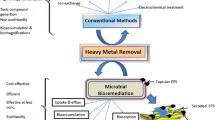Abstract
Microorganisms can remove metals from the surrounding environment with various mechanisms, either as metabolically mediated processes or as a passive adsorption of metals on the charged macromolecules of the cell envelope. Owing to the presence of a large number of negative charges on the external cell layers, exopolysaccharides (EPS)-producing cyanobacteria have been considered very promising as chelating agents for the removal of positively charged heavy metal ions from water solutions, and an increasing number of studies on their use in metal biosorption have been published in recent years. In this review, the attention was mainly focused on the studies aimed at defining the molecular mechanisms of the metal binding to the polysaccharidic exocellular layers. Moreover, the few attempts done in the use of EPS-producing cyanobacteria for metal biosorption at pilot scale and with real wastewaters are here reviewed, discussing the main positive issues and the drawbacks so far emerging from these experiments.
Similar content being viewed by others
References
Ahluwalia SS, Goyal D (2007) Microbial and plant derived biomass for removal of heavy metals from wastewater. Biores Technol 98:2243–2257
Ahuja P, Gupta R, Saxena RK (1999) Sorption and desorption of cobalt by Oscillatoria anguistissima. Curr Microbiol 39:49–52
Anjana K, Anubha K, Kiran B, Nisha R (2007) Biosorption of Cr(VI) by immobilized biomass of two indigenous strains of cyanobacteria isolated from metal contaminated soil. J Hazard Mater 148:383–386
Arica MY, Tüzün İ, Yalçin E, Ince Ö, Bayramoğlu G (2005) Utilisation of native, heat and acid-treated microalgae Chlamydomonas reinhardtii preparations for biosorption of Cr(VI) ions. Process Biochem 40:2351–2358
Bender J, Gould JP, Vatcharapijarn Y, Young JS, Phillips P (1994) Removal of zinc and manganese from contaminated water with cyanobacteria mats. Water Environ Res 66:679–683
Blanco A, Sanz B, Llama MJ, Serra JL (1998) Reutilization of non viable biomass of Phormidium laminosum for metal biosorption. Biotechnol Appl Biochem 27:167–174
Brady D, Letebele B, Duncan JR, Rose PD (1994) Bioaccumulation of metals by Scenedesmus, Selenastrum and Chlorella algae. Water-SA 20:213–218
Brierley CL (1990) Metal immobilization using bacteria. In: Ehrlich HL, Brierley CL (eds) Microbial mineral recovery. McGraw-Hill, New York, pp 303–32
Chan SS, Chow H, Wong MH (1991) Microalgae as bioabsorbents for treating mixture of electroplating and sewage effluent. Biomed Environ Sci 4:250–261
Chakraborty N, Banerjee A, Pal R (2011) Accumulation of lead by free and immobilized cyanobacteria with special reference to accumulation factor and recovery. Biores Technol 102:4191–4195
Chojnacka K (2010) Biosorption and bioaccumulation—the prospects for practical applications. Environ Int 36:299–307
Chojnacka K, Chojnacki A, Go’recka H (2005) Biosorption of Cr3+, Cd2+ and Cu2+ by blue-green algae Spirulina sp.: kinetics, equilibrium and ions the mechanism of the process. Chemosphere 59:75–84
Colica G, Mecarozzi P, De Phillippis R (2010) Treatment of Cr(VI)-containing wastewaters with exopolysaccharide-producing cyanobacteria in pilot flow through and batch systems. Appl Microbiol Biotechnol 87:1953–1961
Dakiky M, Khamis M, Manassra A, Mer'eb M (2002) Selective adsorption of chromium (VI) in industrial wastewater using low-cost abundantly available adsorbents. Adv Environ Res 6:533–540
Davis TA, Volesky B, Mucci A (2003) A review of the biochemistry of heavy metal biosorption by brown algae. Water Res 37:4311–4328
De Philippis R, Micheletti E (2009) Heavy metal removal with exopolysaccharides-producing cyanobacteria. In: Shammas NK, Hung YT, Chen JP, Wang LK (eds) Heavy metals in the environment. CRC Press, Boca Raton, pp 89–122
De Philippis R, Paperi R, Sili C (2007) Heavy metal sorption by released polysaccharides and whole cultures of two exopolysaccharide-producing cyanobacteria. Biodegradation 18:181–187
De Philippis R, Paperi R, Sili C, Vincenzini M (2003) Assessment of the metal removal capability of two capsulated cyanobacteria, Cyanospira capsulata and Nostoc PCC7936. J Appl Phycol 15:155–161
De Philippis R, Sili C, Paperi R, Vincenzini M (2001) Exopolysaccharide-producing cyanobacteria and their possible exploitation: a review. J Appl Phycol 13:293–299
De Philippis R, Vincenzini M (1998) Exocellular polysaccharides from cyanobacteria and their possible applications. FEMS Microbiol Rev 22:151–175
Demirel S, Ustun B, Aslim B, Suledere Z (2009) Toxicity and uptake of irons by Sinechocystis sp. E35 isolated from Kucukcemece Lagoon, Istanbul. J Hazard Mater 171:710–716
De Rome L, Gadd GM (1991) Use of pelleted and immobilized yeast and fungal biomass for heavy metal and radionuclide recovery. J Ind Microbiol 7:97–104
Doshi H, Ray A, Kothari IL (2007a) Bioremediation potential of live and dead Spirulina: spectroscopic, kinetics and SEM studies. Biotechnol Bioeng 96:1051–1063
Doshi H, Ray A, Kothari IL (2007b) Biosorption of cadmium by live and dead Spirulina: IR spectroscopic, kinetics, and SEM studies. Curr Microbiol 54:213–218
El-Enany AE, Issa AA (2000) Cyanobacteria as a biosorbent of heavy metals in sewage water. Environ Toxicol Pharmacol 8:95–101
El-Sheekh MM, El-Shouny WA, Osman MEH, El-Gammal EWE (2005) Growth and heavy metals removal efficiency of Nostoc muscorum and Anabaena subcylindrica in sewage and industrial wastewater effluents. Environ Toxicol Pharm 19:357–365
Ferraz AI, Tavares T, Teixera JA (2004) Cr(III) removal and recovery from Saccharomyces cerevisiae. Chem Eng J 105:11–20
Freire-Nordi CS, Vieira AAH, Nascimento OR (2005) The metal binding capacity of Anabaena spiroides extracellular polysaccharide: an EPR study. Process Biochem 40:2215–2224
Gadd GM (1990) Heavy metal accumulation by bacteria and other microorganisms. Experientia 46:834–840
Gadd GM, White C (1993) Microbial treatment of metal pollution—a working biotechnology? Trends BiotechnoI 11:353–359
Gadd GM (2009) Biosorption: critical review of scientific rationale, environmental importance and significance for pollution treatment. J Chem Technol Biotechnol 84:13–28
Gardea-Torresdey JL, Gonzalez JH, Tieman KJ, Rodriguez O, Gamez G (1998) Phytofitration of hazardous cadmium, chromium, lead and zinc ions by biomass of Medicago sativa (Alfalfa). J Hazard Mater 57:29–39
Garnham GW, Codd GA, Gadd GM (1992) Accumulation of cobalt, zinc and manganese by the estuarine green microalga Chlorella salina immobilized in alginate microbeads. Environ Sci Technol 26:1764–1770
Gong R, Ding YD, Liu H, Chen Q, Liu Z (2005) Lead biosorption by intact and pretreated Spirulina maxima biomass. Chemosphere 58:125–130
Guo XX, Shi Dj, Xu XD, Ouyang YS, Ru BG (1999) Metal-induced expressing of mammal metallothionein-I gene in cyanobacteria to promote cadmium-binding preferences. Appl Microbiol Biotechnol 52:806–810
Gupta VK, Rastogi (2008) A sorption and desorption study of chromium (VI) from nonviable cyanobacterium Nostoc muscorum biomass. J Hazard Mater 152:407–414
Hoiczyk E, Hansel A (2000) Cyanobacterial cell walls: news from an unusual prokaryotic envelope. J Bacteriol 182:1191–1199
Incharoensakdi A, Kitjaharn P (2002) Zinc biosorption from aqueous solution by a halotolerant cyanobacterium Aphanothece halophytica. Curr Microbiol 45:261–264
Inthorn D (2001) Removal of heavy metal by using microalgae. In: Kojima H, Lee YK (eds) Photosynthetic microorganisms in environmental biotechnology. Springer, Hong Kong, pp 111–135
Karma RR, Uma L, Subramanian G, Mohan PM (1999) Biosorption of toxic metal ions by alkali-extracted biomass of a marine cyanobacterium, Phormidium valderianum BDU 30501. World J Microbiol Biotechnol 15:729–732
Kiran B, Kaushik A (2008a) Chromium binding capacity of Lyngbya putealis exopolysaccharides. Biochem Eng J 38:47–54
Kiran B, Kaushik A (2008b) Cyanobacterial biosorption of Cr(VI): application of two parameter and Bohart–Adams models for batch and column studies. Chem Eng J 144:391–399
Kratochvil D, Pimentel P, Volesky B (1998) Removal of trivalent and hexavalent chromium by seaweed biosorbent. Environ Sci Technol 32:2693–2698
Kumar D, Pandey LK, Gaur JP (2010) Evaluation of various isotherm models, and metal sorption potential of cyanobacterial mats in single and multi-metal systems. Colloid Surface B 81:476–485
Kuroda K, Ueda M (2010) Engineering of microorganisms towards recovery of rare metal ions. Appl Microbiol Biotechnol 87:53–60
Lengke M, Fleet ME, Southam G (2006a) Morphology of gold nanoparticles synthesized by filamentous cyanobacteria from gold(I)-thiosulfate and gold(III)-chloride complexes. Langmuir 22:2780–2787
Lengke M, Ravel B, Fleet ME, Wanger G, Gordon RA, Southam G (2006b) Mechanisms of gold bioaccumulation by filamentous cyanobacteria from gold(III)-chloride complex. Environ Sci Technol 40:6304–6309
Les A, Walker WR (1998) Toxicity and binding of copper, zinc, and cadmium by blue-green alga, Chroococcus paris. Water Air Soil Poll 23:129–139
Lo WH, Ng LM, Chua H, Yu PHF, Sin SN, Wong PK (2003) Biosorption and desorption of copper (II) ions by Bacillus sp. Appl Biochem Biotechnol 105:581–591
Machado MD, Soares EV, Soares HMVM (2010) Selective recovery of copper, nickel and zinc from ashes produced from Saccharomyces cerevisiae contaminated biomass used in the treatment of real electroplating effluents. J Hazard Mater 184:357–363
Mehta SK, Gaur JP (2005) Use of algae for removing heavy metal ions from wastewater: progress and prospects. Crit Rev Biotechnol 25:113–152
Micheletti E, Colica G, Viti C, Tamagnini P, De Philippis R (2008a) Selectivity in the heavy metal removal by exopolysaccharide-producing cyanobacteria. J Appl Microbiol 105:88–94
Micheletti E, Pereira S, Mannelli F, Moradas-Ferreira P, Tamagnini P, De Philippis R (2008b) Sheathless mutant of the cyanobacterium Gloethece sp. PCC 6909 with increased capacity to remove copper ions from aqueous solutions. Appl Environ Microbiol l74:2797–2804
Mohamed ZA (2001) Removal of cadmium and manganese by a non-toxic strain of the freshwater cyanobacterium Gloethece magna. Water Res 35:4405–4409
Mubarak AD, Sasikala M, Gunasekaran M, Thajuddin N (2011) Biosynthesis and characterization of silver nanoparticles using marine cyanobacterium, Oscillatoria willei NTDM01. Dig J Nanomat Bios 6:385–390
Nagase H, Inthorn D, Oda A, Nishimura J, Kajiwara Y, Park MO, Hirata K, Miyamoto K (2005) Improvement of selective removal of heavy metals in cyanobacteria by NaOH treatment. J Biosci Bioeng 99:372–377
Nakagawa M, Takamura Y, Yagi O (1987) Isolation and characterization of the slime from a cyanobacterium, Microcystis aeruginosa K-3A. Agric Biol Chem 51:329–337
Nakajima A, Horikoshi T, Sakaguchi T (1982) Recovery of uranium by immobilized microorganisms. Eur J Appl Microbiol Biotechnol 16:88–91
Park D, Yun YS, Park JM (2005) Studies on hexavalent chromium biosorption by chemically-treated biomass of Ecklonia sp. Chemosphere 60:1356–1364
Phoenix VR, Martinez RE, Konhauser KO, Ferris FG (2002) Characterization and implications of the cell surface reactivity of Calothrix sp. strain KC97. Appl Environ Microbiol 68:4827–4834
Okajima MK, Miyazato S, Kaneko T (2009) Cyanobacterial megamolecule sacran efficiently forms LC gels with very heavy metal ions. Langmuir 25:8526–8531
Ozturk S, Aslim B, Suludere Z (2009) Evaluation of chromium (VI) removal behaviour by two isolates of Synechocystis sp. in terms of exopolysaccharide (EPS) production and monomer composition. Bioresour Technol 100:5588–5593
Paperi R, Micheletti E, De Philippis R (2006) Optimization of copper sorbing-desorbing cycles with confined cultures of the exopolysaccharide-producing cyanobacterium Cyanospira capsulata. J Appl Microbiol 101:1351–1356
Parmeggiani AC, Masini JC (2003) Evaluating scatchard and differential equilibrium functions to study the binding properties of Cu (II) to the source of mixed species of lyophilized Spirulina. J Braz Chem Soc 14:416–424
Parker DL, Mihalick JE, Plude JL, Plude MJ, Clark TP, Egan L, Flom JJ, Rai LC, Kumar HD (2000) Sorption of metals by extracellular polymers from the cyanobacterium Microcystis aeruginosa f. flos-aquae strain C3-40. J Appl Phycol 12:219–224
Parker DL, Rai LC, Mallick N, Rai PK, Kumar HD (1998) Effects of cellular metabolism and viability on metal ion accumulation by cultured biomass from a bloom of the cyanobacterium Microcystis aeruginosa. Appl Environ Microbiol 64:1545–1547
Parker DL, Schram BR, Plude JL, Moore RE (1996) Effect of metal cations on the viscosity of a pectin-like capsular polysaccharide from the cyanobacterium Microcystis flosaquae C3-40. Appl Environ Microbiol 62:1208–1213
Pereira S, Micheletti E, Zille A, Santos A, Ferreira PM, Tamagnini P, De Philippis R (2011) Using extracellular polymeric substances (EPS)-producing cyanobacteria for the bioremediation of heavy metals: do cations compete for the EPS functional groups and also accumulate inside the cell? Microbiology 157:451–458
Pereira S, Zille A, Micheletti E, Moradas-Ferreira P, De Philippis R, Tamagnini P (2009) Complexity of cyanobacterial exopolysaccharides: composition, structures, inducing factors and putative genes involved in their biosynthesis and assembly. FEMS Microbiol Rev 33:917–941
Plude JL, Parker DL, Schommer OJ, Timmerman RJ, Hagstrom SA, Joers JM, Hnasko R (1991) Chemical characterization of polysaccharide from the slime layer of the cyanobacterium Microcystis flos-aquae C3-40. Appl Envir Microbiol 57:1696–1700
Pradhan S, Rai LC (2001) Biotechnological potential of Microcystis sp. in Cu, Zn and Cd biosorption from single and multimetallic systems. Biometals 14:67–74
Pradhan S, Singh S, Rai LC (2007) Characterization of various functional groups present in the capsule of Microcystis and study of their role in biosorption of Fe, Ni and Cr. Biores Technol 98:595–601
Rai LC, Singh S, Pradhan S (1998) Biotechnological potential of naturally occurring and laboratory-grown Microcystis in biosorption of Ni2+ and Cd2+. Curr Sci India 74:461–463
Ruangsomboon S, Chidthaisong A, Bunnag B, Inthorn D, Harvey NW (2006) Production, composition and Pb2+ adsorption characteristics of capsular polysaccharides extracted from a cyanobacterium Gloeothece gelatinosa. Water Res 40:3759–3766
Ruangsomboon S, Chidthaisong A, Bunnag B, Inthorn D, Harvey NW (2007) Lead (Pb2+) adsorption characteristics and sugar composition of capsular polysaccharides of cyanobacterium Calothrix marchica. Songklanakarin J Sci Technol 29:529–541
Ringot D, Lerzy B, Chaplain K, Bonhoure J-P, Auclair E, Larondelle Y (2007) In vitro biosorption of ochratoxin A on the yeast industry by-products: comparison of isotherm models. Biores Technol 98:1812–1821
Roeselers G, van Loosdrecht MCM, Muyzer G (2008) Phototrophic biofilms and their potential applications. J Appl Phycol 20:227–235
Shah V, Ray A, Garg N, Madamwar D (2000) Characterization of the extracellular polysaccharide produced by a marine cyanobacterium Cyanothece sp. ATCC 51142, and its exploitation toward metal removal from solutions. Curr Microbiol 40:274–278
Sharma M, Kaushik A, Somvir BK, Kamra A (2008) Sequestration of chromium by exopolysaccharides of Nostoc and Gloeocapsa from dilute aqueous solutions. J Hazard Mater 157:315–318
Sharma NK, Tiwari SP, Tripathi K, Rai AK (2010) Sustainability and cyanobacteria (blue-green algae): facts and challenges. J Appl Phycol doi:https://doi.org/10.1007/s10811-010-9626-3
Shen L, Xia JL, He H, Nie Z (2008) Comparative study on biosorption of Pb(II) and Cr(VI) by Synechococcus sp. Trans Nonferrous Met Oc China 18:1336–1342
Singh N, Asthana RK, Singh SP (2003) Characterization of an exopolysaccharide mutant of Nostoc spongiformae: Zn sorption and uptake. World J Microb Biotechnol 19:851–857
Singh SP, Pradhan S, Rai LC (1998) Comparative assessment of Fe (III) and Cu (II) biosorption by field and laboratory grown Microcystis. Process Biochem 33:495–504
Singh SP, Pradhan S, Rai LC (2000) Metal removal from single and multimetallic systems by different biosorbent materials as evaluated by differential pulsed anodic stripping voltammetry. Process Biochem 36:175–182
Swift DT, Forciniti D (1997) Accumulation of lead by Anabaena cylindrica: mathematical modeling and an energy dispersive X-ray study. Biotech Bioeng 55:408–418
Sutherland IW (2001) Biofilm exopolysaccharides: a strong and sticky framework. Microbiology 147:4–9
Tien CJ (2002) Biosorption of metal ions by freshwater algae with different surface characteristics. Process Biochem 38:605–613
Tien CJ, Sigee DC, White KN (2005) Copper adsorption kinetics of cultured algal cells and freshwater phytoplankton with emphasis on cell surface characteristics. J Appl Phycol 17:379–389
Volesky B (2007) Biosorption and me. Water Res 41:4017–4029
Volesky B, Holan ZR (1995) Biosorption of heavy metals. Biotechnol Prog 11:235–250
Volesky B, Naja G (2007) Biosorption technology: starting up an enterprise. Int J Tech Transf Comm 6:196–211
Wang K, Colica G, De Philippis R, Liu YD, Li DH (2010) Biosorption of copper by cyanobacterial bloom-derived biomass harvested from the eutrophic lake Dianchi in China. Curr Microbiol 61:340–345
Weckesser J, Hofmann K, Jürgens UJ, Whitton BA, Raffelsberger B (1988) Isolation and chemical analysis of the sheaths of the filamentous cyanobacteria Calothrix parietina and C. scopulorum. J Gen Microbiol 134:629–634
Yee N, Benning LG, Phoenix VR, Ferris FG (2004) Characterization of metal–cyanobacteria sorption reactions: a combined macroscopic and infrared spectroscopic investigation. Environ Sci Technol 38:775–782
Acknowledgments
The still unpublished results on Au, Pd, and Ru biosorption, reported in Table 1, have been obtained in a research coordinated by R. De Philippis and carried out by G. Colica, G. Bertini, and S. Caparrotta.
Author information
Authors and Affiliations
Corresponding author
Rights and permissions
About this article
Cite this article
De Philippis, R., Colica, G. & Micheletti, E. Exopolysaccharide-producing cyanobacteria in heavy metal removal from water: molecular basis and practical applicability of the biosorption process. Appl Microbiol Biotechnol 92, 697–708 (2011). https://doi.org/10.1007/s00253-011-3601-z
Received:
Revised:
Accepted:
Published:
Issue Date:
DOI: https://doi.org/10.1007/s00253-011-3601-z




